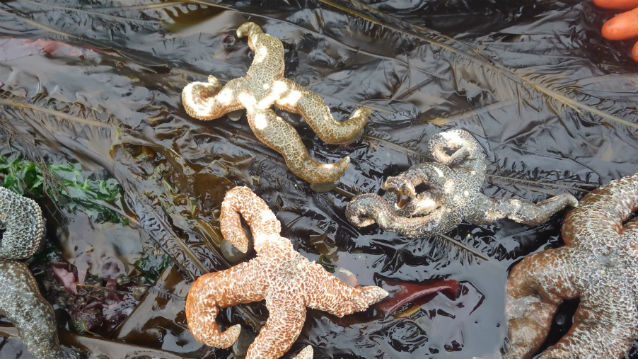Sea Star Wasting Disease: The Catastrophe Beneath the Waves
Published by Ocean Conservancy
As a young graduate student, I first came to the west coast in 1990 to study California’s kelp forests. On my first scuba dive near the world-famous Monterey Bay Aquarium, I was instantly mesmerized. Never had I seen such incredible underwater habitats: 100-foot tall giant kelp plants swaying in the Pacific swell, brightly colored rockfish of all sorts, alien-looking invertebrates blanketing the rocky reefs and, of course, the iconic sea otter. Thirty years later, climate change is now destroying what I fell in love with so long ago.
Last week’s news about my ocean backyard came as a serious blow. A new study by Dr. Drew Harvell from Cornell University and colleagues has documented Pycnopodia helianthoides (arguably the most impressive sea star in the kelp forest and my favorite animal) has been decimated and is now virtually non-existent along a 3,000-mile stretch of coast, from the shallows to 1,300 meters below the surface. A “zombie apocalypse” has been underway beneath the waves since 2013, with sea star wasting disease (SSWD) dissolving more than 20 species of sea stars into puddles of rotting flesh on the seafloor. The scientific publication documents how, this most important of species (colloquially called the sunflower star), has rapidly declined because of the combined effects of this devastating disease and climate-driven ocean heat waves. As we continue to burn fossil fuels, massive amounts of heat are being absorbed by the ocean, which is driving extreme temperature events that appear to increase the lethality of SSWD. This one-two punch is destroying the kelp forest.


“I saw the devastating impacts of sea star wasting disease firsthand while studying sea stars in tide pools along the coast of Oregon for my PhD. Within a few heartbreaking months in 2014, the majority of the sea stars at our research sites had disappeared into piles of mush. This new research on sunflower stars suggests that warming oceans were an important part of sea star declines from the disease. For me, this research highlights just how critical it is that we tackle climate change for the health of our ocean ecosystems.”
Fish Policy Analyst
As I discovered on that first dive, sunflower stars are amazing animals. Nearly the size of a garbage can lid, these 24-armed predators literally gallop along the seafloor voraciously consuming sea urchins and other invertebrates. A classic example of a keystone species, sunflower stars keep purple sea urchin populations in check which, in turn, allows giant kelp to grow prolifically, creating the physical structure that harbors all the other species that collectively comprise the kelp forest.
Science predicts that without the sunflower star—and the other sea stars killed by SSWD—there should be no kelp forests. And that is exactly what is happening. As sea star abundance has tumbled across the west coast, the abundance of kelp has likewise fallen. These once vibrant habitats have increasingly become barren zones, dominated by sea urchins, which mow down giant kelp and everything else in their path. Scientists worry that the kelp forest ecosystem may switch into an alternative state (one without kelp) from which recovery will be difficult unless the disease wanes, cool waters return and purple urchin numbers are somehow reduced.


Devastating changes like this aren’t just happening off the west coast—they are happening all around the world. Coral reefs are suffering from global bleaching events driven by an increasingly hot ocean. Shellfish farmers have suffered from the die off of their crop as coastal waters have become increasingly acidic from the ocean’s relentless absorption of excess carbon dioxide. In short, what is happening along the Pacific coast is not unique—it is an ‘object lesson’ in how climate change is fundamentally altering the ocean.
How do we turn this around? What will it take to secure a safe future for the ocean and all the people that depend on it? Foremost, we must rapidly and decisively embrace a new, low-carbon energy future. Science confirms we have only a decade to avoid catastrophic climate change, both on land and in the ocean. There is no time to waste. Our elected officials must acknowledge these warning signs and work together to advance policies to reduce carbon pollution. A healthy ocean is only achievable if we confront the damage that carbon emissions are having on the world’s ocean now.
At Ocean Conservancy, we are working to secure a future where kelp forests once again thrive all along the Pacific coast. But we won’t succeed unless all of us stand up for the ocean and its creatures, which don’t have a voice to advocate for themselves.
Saving what we love—including my favorite sea star—will take all of us who do have a voice using it.
Sign up for our emails!
The post Sea Star Wasting Disease: The Catastrophe Beneath the Waves appeared first on Ocean Conservancy.
Read the full article at: https://oceanconservancy.org/blog/2019/02/06/sea-star-wasting-disease-catastrophe-beneath-waves/


